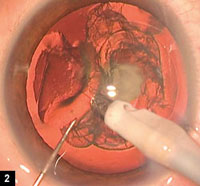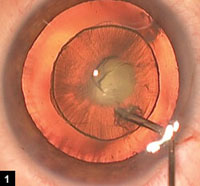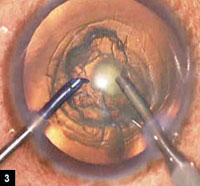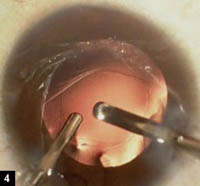OSN Complications Consult column to provide advice on handling problematical cases
Bi-monthly feature will also address new and developing technology to manage these cases. This month we consider posterior polar cataracts.
![Complications Consult [logo]](/~/media/images/shared-images/complications-consult.gif)
In the interest of providing timely information to our colleagues on how to handle problematic surgical cases, we present the new “Complications Consult” column for Ocular Surgery News. Each month we will address complicated cases, as well as the latest in technologies for these cases. I will oversee this column with occasional guest submissions from my colleagues, and I hope you will find these articles useful.
Posterior polar cataracts
![Amar Agarwal, MS, FRCS, FRCOphth [photo]](/~/media/images/news/print/ocular-surgery-news-europe-asia-edition/2006/04_april/agarwal_70_90_6143.jpg) Amar Agarwal |
Posterior polar cataracts are still a major challenge for any phaco surgeon, despite the rapid advances in phaco technology. A better understanding and skillful surgical technique bring down posterior capsular rupture rates in posterior polar cataracts. It also helps in bringing back clear vision.
The posterior polar cataract has a unique circular whorl-like appearance located in the central axis near the nodal point of the eye with the rest of the lens sometimes remaining clear (Figure 1). It is frequently associated with a weakened or deficient posterior capsule. Missing the diagnosis in a posterior polar cataract can be catastrophic. Interdigitation with the posterior capsule is characteristic, as opposed to a posterior subcapsular cataract.
Surgical tips
A small continuous curvilinear capsulorrhexis is aimed for in the eventuality of the IOL having to be placed in the sulcus. Hydrodissection may cause hydraulic perforation at the weakened area of the capsule, therefore, a carefully controlled hydrodelineation is preferred (Figure 1). This epinuclear shell provides additional protection by tamponading any vitreous or capsular breach during phacoemulsification. A small amount of viscoelastic can be injected just under the rim of the capsulorrhexis all around to form a mechanical barrier for fluid from accidentally entering the subcapsular plane while performing hydrodelineation.
Since the nucleus after hydrodelineation is very small, it can be removed easily either by carouselling it out with the phaco tip (Figure 2) or with a chop maneuver. Phaco chop is especially helpful in cases of associated nuclear sclerosis. If the central plaque had not been removed at the time of surgery, it can be tackled by a YAG capsulotomy postoperatively.
|
|  Phaco being performed in a posterior polar cataract. |
|
|
|
| Images: Agarwal A et al | |
Sub-1-mm: 700-µm cataract surgery
Microphaconit or bimanual phacoemulsification through two 0.7-mm instruments (an irrigating chopper and a phaco needle) can be used effectively to tackle a posterior polar cataract (Figure 3). Hydrodelineation can be done through both ports here.
Another advantage of this technique is that one can easily revert to bimanual vitrectomy in case of vitreous loss. The advantage of microphakonit over phaco is that one has a closed chamber throughout surgery as both the incisions are so small.
Spatula
Another technique for removing soft nuclei is by first performing hydrofree dissection where a blunt spatula is used to lyse corticocapsular adhesions by passing it up to the equatorial fornix. The nucleus is then progressively debulked in the inferior half.
The remaining superior nucleus is then brought to the center with a combination of viscodisplacement and manual maneuvering, and is then removed.
| Posterior polar cataract: Key points |
| Posterior polar cataract (PPC) is a clinically distinctive entity consisting of a dense white, well-demarcated, disc-shaped opacity located in the posterior cortex or subcapsular region. Two types of PPC have been described in the literature: stationary and progressive. The bull’s eye appearance is pathognomonic of posterior polar cataracts. Cortical cleaving hydrodissection can lead to hydraulic rupture and should be avoided. It would be logical to perform hydrodelineation to create a mechanical cushion of epinucleus. It is critical that the hydrodelineation needle be inserted into a plane away from the height of the polar cataract so that when a wavefront is created, the posterior capsule is not ruptured. At times the classical appearance suggestive of a defect is observed in the posterior cortex, but the posterior capsule remains intact. This is a “pseudohole.” Source: Agarwal A |
Capsular rupture
If a capsular tear does occur, several steps can help minimize vitreous loss. A closed system should be maintained by injecting viscoelastic before withdrawing the phaco tip. This helps to tamponade the vitreous backward where a capsular dehiscence is present. Cortical removal should then proceed with either low infusion or by a dry technique filling the chamber with viscoelastic material and using a Simcoe aspirator.
If the hyaloid face is broken and vitreous presents through the rupture, a routine two-port mechanized vitrectomy (Figure 4) using low flow and low vacuum parameters is performed. The tear can then be converted into a round and stable opening. The IOL can then be safely placed into the capsular bag. An uncontrolled tear necessitates implantation into the ciliary sulcus. A 6-mm optic acrylic lens should be used when implanting in the bag as it unfolds slowly, thus causing less stress on the posterior capsule. The leading edge of the lens should be directed away from the weak area of the capsule.
In the June issue
The temporary haptic externalization technique will be described.
For Your Information:
- Amar Agarwal, MS, FRCS, FRCOphth, director of Dr. Agarwal’s Group of Eye Hospitals, trains surgeons internationally in phacoemulsification, phakonit, LASIK and retinal lasers. Dr. Agarwal is author of several books published by SLACK, Incorporated, publisher of Ocular Surgery News, including Phaco Nightmares: Conquering Cataract Catastrophes, Bimanual Phaco: Mastering the Phakonit/MICS Technique, Dry Eye: A Practical Guide to Ocular Surface Disorders and Stem Cell Surgery, and Presbyopia: A Surgical Textbook. He can be reached at 19 Cathedral Road, Chennai 600 086, India; fax: 91-44-28115871; e-mail: dragarwal@vsnl.com; Web site: www.dragarwal.com.
References:
- Agarwal S, Agarwal A, Agarwal A, eds. Phacoemulsification. 3rd ed. Thorofare, NJ: SLACK Incorporated; 2004.
- Agarwal A. Phaco Nightmares: Conquering Cataract Catastrophes. Thorofare, NJ: SLACK Incorporated; 2006 (in press).



